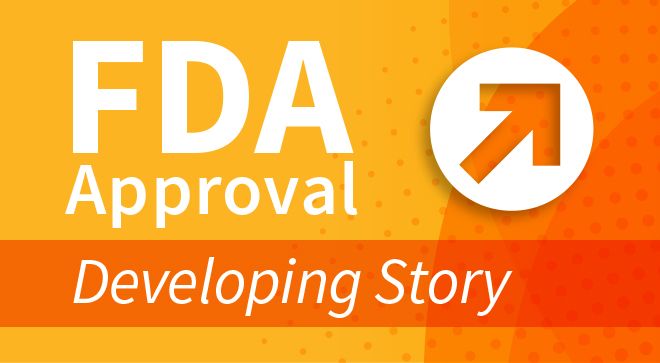Article
FDA Approves Halaven for Advanced Liposarcoma
Author(s):
The approval of Halaven was based on an improvement in overall survival (OS) in a phase 3 study.
The FDA has approved Halaven (eribulin mesylate) as a treatment for patients with advanced or unresectable liposarcoma following prior treatment with an anthracycline-based chemotherapy. The approval was based on an improvement in overall survival (OS) in a phase 3 study.
In a subpopulation of 143 patients in study with liposarcoma, the microtubule dynamics inhibitor Halaven demonstrated a median OS of 15.6 months compared with 8.4 months in those who received dacarbazine. These findings mark the first time that an agent has shown a survival benefit for patients with liposarcoma, according to the FDA.
“Halaven is the first drug approved for patients with liposarcoma that has demonstrated an improvement in survival time,” Richard Pazdur, director of the Office of Hematology and Oncology Products in the FDA’s Center for Drug Evaluation and Research, said in a statement. “The clinical trial data the FDA reviewed indicates that Halaven increased overall survival by approximately seven months, offering patients a clinically meaningful drug.”
Findings from the open-label phase 3 trial were presented at the 2015 meeting of the American Society of Clinical Oncology. Under the Prescription Drug User Fee Act, the FDA was scheduled to make a decision on the application by March 30, placing their decision approximately two months ahead of deadline.
In the pivotal phase 3 study, 452 patients with advanced soft tissue sarcoma were randomized to receive Halaven (228 patients) or dacarbazine (224 patients). Halaven was administered at 1.4 mg/m2 on days 1 and 8 and dacarbazine was administered at 850, 1000 or 1200 mg/m2 on day 1 of each 21-day cycle.
Patients enrolled had high- or intermediate-grade sarcoma and the majority had received two or more prior therapies. Overall, 143 patients had liposarcoma and 309 had leiomyosarcoma. The primary endpoint of the study was OS, with secondary outcomes focused on progression-free survival (PFS) and safety.
Across the full study, median OS with Halaven was 13.5 months compared with 11.5 months for dacarbazine, representing a 23 percent reduction in the risk of death. In patients with leiomyosarcoma, median OS was 12.7 months with Halaven versus 13 months with dacarbazine (145 patients).
Median PFS was 2.6 months in both arms of the study across the full population. The 12-week PFS rate was 33 percent with Halaven and 28.6 percent with dacarbazine; however, this difference was not deemed statistically significant.
The objective response rate (all partial responses) was 3.9 percent with Halaven versus 4.9 percent with dacarbazine. The stable disease rate with Halaven was 52.2 percent compared with 47.8 percent with dacarbazine.
"This is the very first phase 3 trial investigating patients with soft tissue sarcoma to demonstrate an overall survival benefit of a new agent compared with an active agent," lead investigator Patrick Schöffski, head of Department of General Medical Oncology, University Hospitals Leuven in Leuven, Belgium, said when the data were presented. "This is a clinically meaningful result given the high unmet medical need in this rare, hard-to-treat family of diseases."
All-grade adverse events (AEs) were seen in almost all patients in the study. The most common AEs in the Halaven arm were neutropenia (43.8 percent), fatigue (43.8 percent), nausea (40.3 percent), alopecia (35 percent) and constipation (31.4 percent). With dacarbazine, the most common AEs were nausea (47.3 percent), fatigue (38.4 percent), anemia (30.8 percent), thrombocytopenia (27.7 percent) and constipation (25.9 percent).
Treatment-related AEs of at least grade 3 were reported in 67.3 percent of patients treated with Halaven compared with 56.3 percent with dacarbazine. The most common AEs of at least grade 3 with Halaven were neutropenia (35.4 percent) and anemia (7.1 percent) versus neutropenia (15.6 percent), anemia (12.1 percent) and thrombocytopenia (15.2 percent).
The FDA initially approved Halaven in 2010 for the treatment of patients with metastatic breast cancer. This approval was based on a 2.5-month extension in OS experienced by patients treated with Halaven compared with physician's choice of treatment in the phase 3 EMBRACE trial. The treatment continues to be assessed in clinical trials across a variety of settings.
Schöffski P, Maki RG, Italiano A, et al. Randomized, open-label, multicenter, phase III study of eribulin versus dacarbazine in patients (pts) with leiomyosarcoma (LMS) and adipocytic sarcoma (ADI). J Clin Oncol. 2015;(suppl; abstr LBA10502).





